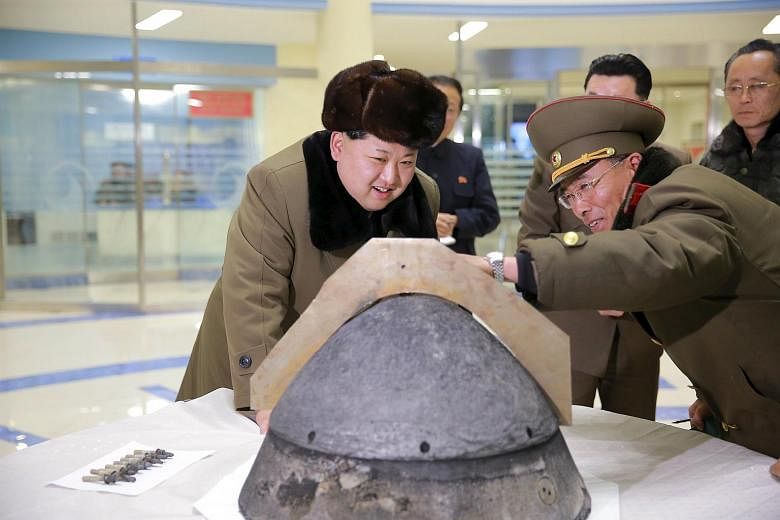SEOUL (AFP/REUTERS) - North Korea fired two ballistic missiles into the sea off its eastern coast on Friday (March 18), in its latest violation of UN resolutions just days after leader Kim Jong Un ordered further nuclear warhead and missile tests, a United States defence official said.
"The US tracked the launch of two ballistic missiles from North Korea. Both are believed to be Nodong MRBMs," the official said on condition of anonymity, referring to medium-range ballistic missiles.
"These launches are a violation of multiple UN Security Council resolutions," the official added.
South Korea said earlier that North Korea had fired what appeared to be at least one medium-range missile into the Sea of Japan on Friday.
A ministry spokesman said the first missile was launched from Sukchon in the country's southwest at 5.55am (4.55am Singapore time) and it flew 800km into the East Sea, also called Sea of Japan.
He did not confirm the type of missile, but South Korea's Yonhap news agency cited military sources as saying it was a Rodong missile, a scaled-up Scud variant with a maximum range of around 1,300km.
The second projectile launched soon after the first and from the same region near the North's west coast disappeared from radar at an altitude of about 17km, the South's Office of the Joint Chiefs of Staff said in a statement.
Further analysis was needed to determine the nature of the second projectile, it said. South Korea's Yonhap news agency said the second projectile may have disintegrated mid-air.
The US State Department said in a statement that it was closely monitoring the situation.
"We call again on North Korea to refrain from actions that further raise tensions in the region and focus instead on taking concrete steps toward fulfilling its international commitments and obligations," spokesman John Kirby said.
"The United States remains steadfast in its commitments to the defense of its allies, including the Republic of Korea and Japan. We will continue to coordinate closely with our allies and partners in the region," he added.
Japanese Prime Minister Shinzo Abe said on Friday that Tokyo strongly condemned the latest ballistic missile launch and demanded that Pyongyang refrain from such actions.
Mr Abe, speaking to Parliament, also said Japan had lodged a protest with North Korea over the launch, which he described as"extremely problematic".
"Japan strongly demands North Korea to exercise self-restraint and will take all necessary measures, such as warning and surveillance activity, to be able to respond to any situations," Mr Abe said.
Military tensions have been soaring on the divided Korean Peninsula since the North carried out its fourth nuclear test on Jan 6, followed a month later by a long-range rocket launch that was widely seen as a disguised ballistic missile test.
The United Nations Security Council responded earlier this month by imposing its toughest sanctions on North Korea to date.
United States President Barack Obama signed an order on Wednesday implementing the UN sanctions, as well as a series of unilateral US sanctions adopted by Congress.
Pyongyang, meanwhile, has maintained a daily barrage of nuclear strike threats against both Seoul and Washington, ostensibly over ongoing, large-scale South Korea-US military drills that the North sees as provocative rehearsals for invasion. To register its anger at the joint exercises, the North fired two short-range missiles into the East Sea on March 10.
A few days later, North Korean leader Kim Jong Un announced that a nuclear warhead explosion test and firings of "several kinds" of ballistic rockets would be carried out "in a short time".
Existing UN sanctions ban North Korea from the use of any ballistic missile test, although short-range launches tend to go unpunished.
A Rodong test would be more provocative, given its greater range which makes it capable of hitting most of Japan. The last Rodong test was in March 2014, when two of the missiles were fired into the East Sea.
While North Korea is known to have a small stockpile of nuclear weapons, its ability to deliver them accurately to a chosen target on the tip of a ballistic missile has been a subject of heated debate.
There are numerous question marks over the North's weapons delivery systems, with many experts believing it is still years from developing a working inter-continental ballistic missile (ICBM) that could strike the continental United States.
Mr Kim's announcement of further tests on Tuesday cams as he monitored what was described as the successful simulated test of the warhead re-entry technology required for such a long-range nuclear attack.
The test was a complete success, state media said, and provided a "sure guarantee" of the warhead's ability to withstand the intense heat and vibration of re-entry - a major step in the North's push towards a genuine ICBM nuclear strike capability.
South Korea said it doubted the North had mastered re-entry technology, although it was less sceptical a few days before when Mr Kim said it had miniaturised a nuclear warhead that could fit on a missile.
Earlier this week, South Korean President Park Geun Hye said North Korea's endless threats and provocative behaviour reflected a "sense of crisis" in Pyongyang at its increasing diplomatic and economic isolation.
"If North Korea continues its provocations and confrontation with the international community and does not walk the path of change, it will walk the path of self-destruction," Ms Park said.

